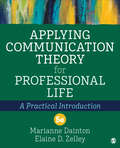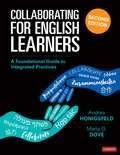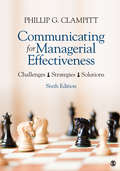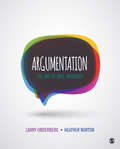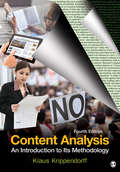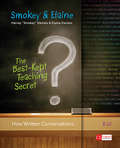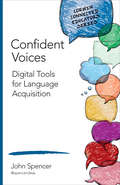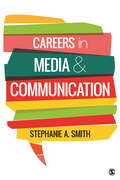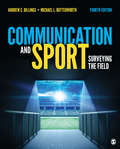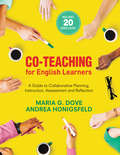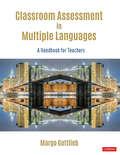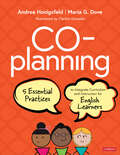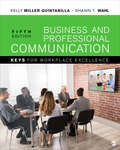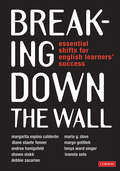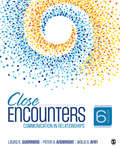- Table View
- List View
Applying Communication Theory for Professional Life: A Practical Introduction
by Marianne Dainton Elaine D. ZelleyNow in its fifth edition, Applying Communication Theory for Professional Life is the first communication theory textbook to provide practical material for career-oriented students. Featuring new case studies, updated examples, and the latest research, authors Marianne Dainton and Elaine D. Zelley introduce communication theory in a way that helps students understand its importance to careers in communication and business. Real-world case studies within each chapters are designed for in-class use to illustrate the application of theory in a variety of professional settings. The Fifth edition features eight new theories, a new chapter on theories of strategic communication, and expanded discussions of mediated communication theories.
Collaborating for English Learners: A Foundational Guide to Integrated Practices
by Maria G. Dove Andrea HonigsfeldLooking for a silver bullet to accelerate EL achievement? There is none. But this, we promise: when EL specialists and general ed teachers pool their expertise, your ELs’ language development and content mastery will improve exponentially. Just ask the tens of thousands of Collaboration and Co-Teaching users and now, a new generation of educators, thanks to this all-new second edition: Collaborating for English Learners. Why this new edition? Because more than a decade of implementation has generated for Andrea Honigsfeld and Maria Dove new insight into what exemplary teacher collaboration looks like, which essential frameworks must be established, and how integrated approaches to ELD services benefit all stakeholders. Essentially a roadmap to the many different ways we can all work together, this second edition of Collaborating for English Learners features: All-new examples, case studies, illustrative video, and policy updates In-depth coverage of the full range of strategies and configurations for determining the best model to adopt Templates, planning guides, and other practical tools to put collaboration into practice Guidelines, self-assessments, and questionnaires for evaluating the strategies’ effectiveness By this time, the big benefits of teacher collaboration are well documented. Where teachers and schools struggle still is determining the best way to do so, especially when working with our ELs. That’s where Andrea Honigsfeld, Maria Dove, and their second edition of Collaborating for English Learners will prove absolutely indispensable. After all, there are no two better authorities.
Communicating for Managerial Effectiveness: Challenges | Strategies | Solutions
by Phillip G. ClampittAppreciated by thousands of thoughtful students, successful managers, and aspiring senior leaders around the world Communicating for Managerial Effectiveness skillfully integrates theory, research, and real-world case studies into models designed to guide thoughtful responses to complex communication issues. The highly anticipated Sixth Edition builds on the strategic principles and related tactics highlighted in previous editions to show readers how to add value to their organizations by communicating more effectively. Author Phillip G. Clampitt (Blair Endowed Chair of Communication at the University of Wisconsin–Green Bay) addresses common communication problems experienced in organizations, including: Communicating about major changes spanning organizational boundaries Selecting the proper communication technologies Transforming data into knowledge Addressing ethical dilemmas Providing useful performance feedback Structuring and using robust decision-making practices Cultivating the innovative spirit Building a world-class communication system
Argumentation: The Art of Civil Advocacy
by Larry B. Underberg Heather NortonArgumentation: The Art of Civil Advocacy teaches students the principles of argumentation as a practical way to engage in interpersonal and public deliberation. Authors Larry Underberg and Heather Norton offer a unique approach for creating civil discourse by encouraging students to consider how they argue with others to enhance or diminish opportunities for future dialogue. A variety of everyday examples are provided in the text to demonstrate how well-reasoned argumentation can strengthen communities and create productive citizenship. Students gain a better understanding for the situations, environments, and relationships that form the context for an advocate, and how those factors can influence discourse.
Content Analysis: An Introduction to Its Methodology
by Klaus KrippendorffWhat matters in people’s social lives? What motivates and inspires our society? How do we enact what we know? Since the first edition published in 1980, Content Analysis has helped shape and define the field. In the highly anticipated Fourth Edition, award-winning scholar and author Klaus Krippendorff introduces readers to the most current method of analyzing the textual fabric of contemporary society. Students and scholars will learn to treat data not as physical events but as communications that are created and disseminated to be seen, read, interpreted, enacted, and reflected upon according to the meanings they have for their recipients. Interpreting communications as texts in the contexts of their social uses distinguishes content analysis from other empirical methods of inquiry. Organized into three parts, Content Analysis first examines the conceptual aspects of content analysis, then discusses components such as unitizing and sampling, and concludes by showing readers how to trace the analytical paths and apply evaluative techniques. The Fourth Edition has been completely revised to offer readers the most current techniques and research on content analysis, including new information on reliability and social media. Readers will also gain practical advice and experience for teaching academic and commercial researchers how to conduct content analysis.
The Best-Kept Teaching Secret: How Written Conversations Engage Kids, Activate Learning, Grow Fluent Writers . . . K-12 (Corwin Literacy)
by Elaine Daniels Smokey DanielsYour fast-track to student engagement Everywhere Smokey Daniels goes—every school he visits, every workshop he leads, every keynote he gives—there’s one teaching strategy that teachers embrace above all others. That single method for transforming students from passive spectators into active learners . . . for evoking curiosity, inspiring critical thinking, and building powerful writers along the way. Now, with Elaine Daniels as Smokey’s coauthor, that best-kept teaching secret is revealed to teachers at large: Written Conversations. Just what make Written Conversations so potent? An ongoing, thoughtful correspondence between students, and between students and their teachers, Written Conversations, above all else, catch and ride the wave of social interaction, which in turn makes school matter to kids. It’s that simple. Structure by structure, from beginning to end, Smokey and Elaine describe four variations of these "silent writing-to-learn discussions," during which all students in a classroom think and "talk" at once in writing, instead of one at a time out loud. How Written Conversations Work It all starts with mini-memos, short student letters that teachers use to introduce, extend, and assess class work. Then come dialogue journals, where pairs dive deeply into academic subjects. Next, groups of three or four students join in extended written discussions called write-arounds. Finally, kids take their thinking online, where they enjoy digital discussions with partners from their own classroom—and with kids from around the world. . . . all the while, you are supported by detailed descriptions of each structure, lessons, and annotated student samples—making this the most practical teaching book in recent memory. What kid wouldn’t want to refine written argument skills, clarify a point, or defend another’s viewpoint, when the "audience" is people who matter? And Yes, Written Conversations align with the Common Core Standards for writing, reading, language, and speaking and listening, taking students well beyond the standards themselves.
Applying Communication Theory for Professional Life: A Practical Introduction
by Marianne Dainton Elaine D. ZelleyNow in its fifth edition, Applying Communication Theory for Professional Life is the first communication theory textbook to provide practical material for career-oriented students. Featuring new case studies, updated examples, and the latest research, authors Marianne Dainton and Elaine D. Zelley introduce communication theory in a way that helps students understand its importance to careers in communication and business. Real-world case studies within each chapters are designed for in-class use to illustrate the application of theory in a variety of professional settings. The Fifth edition features eight new theories, a new chapter on theories of strategic communication, and expanded discussions of mediated communication theories.
Confident Voices: Digital Tools for Language Acquisition (Corwin Connected Educators Series)
by John T. SpencerEngage your ELL students through technology! When it comes to technology integration, don’t overlook the needs of your ELL students. Introduce project-based learning into your classroom and utilize strategies to engage your ELL students and bridge the growing divide between technology and the ELL students that need it to thrive. Connected Educator John Spencer shows ELL educators how to combine technology with teaching in this easy-to-use guide to blended learning. Get ready to: Blend innovative technology with project-based learning Strengthen your students’ English language skills Engage your students through the intentional integration of digital tools The Corwin Connected Educators series is your key to unlocking the greatest resource available to all educators: other educators. Being a Connected Educator is more than a set of actions: it’s a belief in the potential of technology to fuel lifelong learning."John Spencer is the kind of teacher that I wish my own kids had and that all students deserve. This book shows clearly and practically how technology can be used to give all students greater choice and a more powerful voice. This book inspired me to rethink my own approach and what I′m planning to do in my classroom tomorrow." Philip Cummings, 6th Grade Teacher Presbyterian Day School "Spencer provides a clear framework for teachers to help students improve their language skills. A teacher can pick this book up and be provided with specific ideas and techniques which can be implemented in a classroom immediately." Josh Stumpenhorst, Teacher Lincoln Junior High School Naperville, IL
Careers in Media and Communication
by Stephanie A. SmithCareers in Media and Communication is a practical resource that helps students understand how a communication degree prepares them for a range of fulfilling careers; it gives students the skills they will need to compete in a changing job market. Award-winning teacher and author Stephanie A. Smith draws from her years of professional experience to guide students through the trends and processes of identifying, finding, and securing a job in in mass communication. Throughout the book, students explore the daily lives of professionals currently working in the field, as well as gain firsthand insights into the training and experience that hiring managers seek.
Communication and Sport: Surveying the Field
by Andrew C. Billings Michael L. ButterworthCommunication and Sport: Surveying the Field provides students with an understanding of sports media, rhetoric, culture, and organizations through an examination of a wide range of topics. Authors Andrew C. Billings and Michael L. Butterworth address everything from youth to amateur to professional sports through varied lenses, including mythology, community, and identity. A comprehensive focus on communication scholarship gives attention to the ways that sports produce, maintain, or resist cultural attitudes about race, gender, sexuality, class, and politics. The Fourth Edition includes new interviews with prominent figures in the field and new discussions on current events like the Black Lives Matter movement and the COVID-19 pandemic.
Content Analysis: An Introduction to Its Methodology
by Klaus KrippendorffWhat matters in people’s social lives? What motivates and inspires our society? How do we enact what we know? Since the first edition published in 1980, Content Analysis has helped shape and define the field. In the highly anticipated Fourth Edition, award-winning scholar and author Klaus Krippendorff introduces readers to the most current method of analyzing the textual fabric of contemporary society. Students and scholars will learn to treat data not as physical events but as communications that are created and disseminated to be seen, read, interpreted, enacted, and reflected upon according to the meanings they have for their recipients. Interpreting communications as texts in the contexts of their social uses distinguishes content analysis from other empirical methods of inquiry. Organized into three parts, Content Analysis first examines the conceptual aspects of content analysis, then discusses components such as unitizing and sampling, and concludes by showing readers how to trace the analytical paths and apply evaluative techniques. The Fourth Edition has been completely revised to offer readers the most current techniques and research on content analysis, including new information on reliability and social media. Readers will also gain practical advice and experience for teaching academic and commercial researchers how to conduct content analysis.
Co-Teaching for English Learners: A Guide to Collaborative Planning, Instruction, Assessment, and Reflection
by Maria G. Dove Andrea Honigsfeld"Dove and Honigsfeld′s new book arrives at the perfect time as an increasing number of schools move to a collaborative instructional model and are searching for guidance. The authors not only tell us how to effectively collaborate and co-teach to benefit English learners, they actually show us what each component of the collaborative instructional cycle looks and feels like, complemented by innovative video and web content." —DIANE STAEHR FENNER, Coauthor of Unlocking ELs’ Potential and President of SupportEd Because teacher collaboration isn’t an option, it’s a MUST! The proof is borne out by any assessment: our non-native speakers learn faster and achieve more when general ed teachers and EL specialists co-plan and co-deliver instruction in the very same classroom. That’s why you’ll want to put Co-Teaching for English Learners at the top of your reading list. Step by step, EL authorities Maria Dove and Andrea Honigsfeld walk you through the entire collaborative instruction cycle, along with seven potential classroom configurations from which to choose. Whether you’re new to co-teaching or just see room for improvement in your practice, this practical handbook delivers every technique and tool you need to make the most of your collaboration, including video footage of co-teaching in action. Inside you’ll find: • In-depth profiles of the seven models, with detailed descriptions and analyses • A review of advantages and challenges of each model’s implementation • Clear explanations of each teacher’s role along with self-assessment tools • Tried-and-true strategies for the entire instructional cycle: co-planning, co-instruction, co-assessment, and reflection • Real-life accounts from co-teaching veterans Long gone are the days when our ELs are taught in isolation—and rightfully so. Read Co-Teaching for English Learners, implement its strategies, and soon enough you, too, can set up a learning environment in which all students thrive.
Classroom Assessment in Multiple Languages: A Handbook for Teachers
by Margo GottliebWhat if multilingual learners had the freedom to interact in more than one language with their peers during classroom assessment? What if multilingual learners and their teachers in dual language settings had opportunities to use assessment data in multiple languages to make decisions? Just imagine the rich linguistic, academic, and cultural reservoirs we could tap as we determine what our multilingual learners know and can do. Thankfully, Margo Gottlieb is here to provide concrete and actionable guidance on how to create assessment systems that enable understanding of the whole student, not just that fraction of the student who is only visible as an English learner. With Classroom Assessment in Multiple Languages as your guide, you’ll: Better understand the rationale for and evidence on the value and advantages of classroom assessment in multiple languages Add to your toolkit of classroom assessment practices in one or multiple languages Be more precise and effective in your assessment of multilingual learners by embedding assessment as, for, and of learning into your instructional repertoire Recognize how social-emotional, content, and language learning are all tied to classroom assessment Guide multilingual learners in having voice and choice in the assessment process Despite the urgent need, assessment for multilingual learners is generally tucked into a remote chapter, if touched upon at all in a book; the number of resources narrows even more when multiple languages are brought into play. Here at last is that single resource on how educators and multilingual learners can mutually value languages and cultures in instruction and assessment throughout the school day and over time. We encourage you to get started right away. “Margo Gottlieb has demonstrated why the field, particularly the field as it involves the teaching of multilingual learners, needs another assessment book, particularly a book like this. . . . Classroom Assessment in Multiple Languages quite likely could serve as a catalyst toward the beginning of an enlightened discourse around assessment that will benefit multilingual learners.” ~Kathy Escamilla
Argumentation: The Art of Civil Advocacy
by Larry B. Underberg Heather NortonArgumentation: The Art of Civil Advocacy teaches students the principles of argumentation as a practical way to engage in interpersonal and public deliberation. Authors Larry Underberg and Heather Norton offer a unique approach for creating civil discourse by encouraging students to consider how they argue with others to enhance or diminish opportunities for future dialogue. A variety of everyday examples are provided in the text to demonstrate how well-reasoned argumentation can strengthen communities and create productive citizenship. Students gain a better understanding for the situations, environments, and relationships that form the context for an advocate, and how those factors can influence discourse.
Co-Planning: Five Essential Practices to Integrate Curriculum and Instruction for English Learners
by Maria G. Dove Andrea HonigsfeldPool your collective wisdom in support of your English learners! English Learners (ELs) and multilingual learners (MLs) have double the work of their English-speaking peers as they are required to master language and content simultaneously. To support this dynamic academic and language development process, all teachers need to have an understanding of language acquisition and EL/ML-specific methodologies along with offering social-emotional support to ELs/MLs and work in tandem with each other. Bestselling authors Andrea Honigsfeld and Maria G. Dove have returned with this new resource that complements and expands on their previous titles on co-teaching and collaboration by addressing collaborative planning in greater depth. Co-planning is positioned as the first step toward integrative language and content instruction as regular and purposeful collaboration ensures that Els/MLs have access to core content. Key features include: • Practical, step-by-step guidance to starting and sustaining collaborative planning for integrated language, literacy, and social-emotional development • An array of checklists, templates, and protocols for immediate implementation • Snapshots from the Field provide real-life examples of co-planning in action • Beautiful full-color design with original sketch notes to bring concepts to life • QR codes that link to author interviews elaborating on key ideas This substantial guide will assist novice and seasoned educators alike in their move away from isolated practices and help them engage in collaborative planning and professional dialogue about asset-based, best practices for ELs/MLs.
Classroom Assessment in Multiple Languages: A Handbook for Teachers
by Margo GottliebWhat if multilingual learners had the freedom to interact in more than one language with their peers during classroom assessment? What if multilingual learners and their teachers in dual language settings had opportunities to use assessment data in multiple languages to make decisions? Just imagine the rich linguistic, academic, and cultural reservoirs we could tap as we determine what our multilingual learners know and can do. Thankfully, Margo Gottlieb is here to provide concrete and actionable guidance on how to create assessment systems that enable understanding of the whole student, not just that fraction of the student who is only visible as an English learner. With Classroom Assessment in Multiple Languages as your guide, you’ll: Better understand the rationale for and evidence on the value and advantages of classroom assessment in multiple languages Add to your toolkit of classroom assessment practices in one or multiple languages Be more precise and effective in your assessment of multilingual learners by embedding assessment as, for, and of learning into your instructional repertoire Recognize how social-emotional, content, and language learning are all tied to classroom assessment Guide multilingual learners in having voice and choice in the assessment process Despite the urgent need, assessment for multilingual learners is generally tucked into a remote chapter, if touched upon at all in a book; the number of resources narrows even more when multiple languages are brought into play. Here at last is that single resource on how educators and multilingual learners can mutually value languages and cultures in instruction and assessment throughout the school day and over time. We encourage you to get started right away. “Margo Gottlieb has demonstrated why the field, particularly the field as it involves the teaching of multilingual learners, needs another assessment book, particularly a book like this. . . . Classroom Assessment in Multiple Languages quite likely could serve as a catalyst toward the beginning of an enlightened discourse around assessment that will benefit multilingual learners.” ~Kathy Escamilla
Business and Professional Communication: KEYS for Workplace Excellence
by Shawn T. Wahl Kelly MillerOrganized around the transition from student to professional life, Business and Professional Communication, Fifth Edition gives readers the tools they need to move from interview candidate to team member to leader. Coverage of new communication technology and social media, and an emphasis on building skills for business writing and presentations help students gain a deeper understanding of the role of communication in successfully handling situations like job interviewing, providing feedback to supervisors, and working in teams. This title is accompanied by a complete teaching and learning package. Learning Platform / Courseware SAGE Vantage is an intuitive learning platform that integrates quality SAGE textbook content with assignable multimedia activities and auto-graded assessments to drive student engagement and ensure accountability. Unparalleled in its ease of use and built for dynamic teaching and learning, Vantage offers customizable LMS integration and best-in-class support. It’s a learning platform you, and your students, will actually love. Assignable Video with Assessment Assignable video (available in SAGE Vantage) is tied to learning objectives and curated exclusively for this text to bring concepts to life. LMS Cartridge: Import this title’s instructor resources into your school’s learning management system (LMS) and save time. Don’t use an LMS? You can still access all of the same online resources for this title via the password-protected Instructor Resource Site.
Co-Teaching for English Learners: A Guide to Collaborative Planning, Instruction, Assessment, and Reflection
by Maria G. Dove Andrea Honigsfeld"Dove and Honigsfeld′s new book arrives at the perfect time as an increasing number of schools move to a collaborative instructional model and are searching for guidance. The authors not only tell us how to effectively collaborate and co-teach to benefit English learners, they actually show us what each component of the collaborative instructional cycle looks and feels like, complemented by innovative video and web content." —DIANE STAEHR FENNER, Coauthor of Unlocking ELs’ Potential and President of SupportEd Because teacher collaboration isn’t an option, it’s a MUST! The proof is borne out by any assessment: our non-native speakers learn faster and achieve more when general ed teachers and EL specialists co-plan and co-deliver instruction in the very same classroom. That’s why you’ll want to put Co-Teaching for English Learners at the top of your reading list. Step by step, EL authorities Maria Dove and Andrea Honigsfeld walk you through the entire collaborative instruction cycle, along with seven potential classroom configurations from which to choose. Whether you’re new to co-teaching or just see room for improvement in your practice, this practical handbook delivers every technique and tool you need to make the most of your collaboration, including video footage of co-teaching in action. Inside you’ll find: • In-depth profiles of the seven models, with detailed descriptions and analyses • A review of advantages and challenges of each model’s implementation • Clear explanations of each teacher’s role along with self-assessment tools • Tried-and-true strategies for the entire instructional cycle: co-planning, co-instruction, co-assessment, and reflection • Real-life accounts from co-teaching veterans Long gone are the days when our ELs are taught in isolation—and rightfully so. Read Co-Teaching for English Learners, implement its strategies, and soon enough you, too, can set up a learning environment in which all students thrive.
Confident Voices: Digital Tools for Language Acquisition (Corwin Connected Educators Series)
by John T. SpencerEngage your ELL students through technology! When it comes to technology integration, don’t overlook the needs of your ELL students. Introduce project-based learning into your classroom and utilize strategies to engage your ELL students and bridge the growing divide between technology and the ELL students that need it to thrive. Connected Educator John Spencer shows ELL educators how to combine technology with teaching in this easy-to-use guide to blended learning. Get ready to: Blend innovative technology with project-based learning Strengthen your students’ English language skills Engage your students through the intentional integration of digital tools The Corwin Connected Educators series is your key to unlocking the greatest resource available to all educators: other educators. Being a Connected Educator is more than a set of actions: it’s a belief in the potential of technology to fuel lifelong learning."John Spencer is the kind of teacher that I wish my own kids had and that all students deserve. This book shows clearly and practically how technology can be used to give all students greater choice and a more powerful voice. This book inspired me to rethink my own approach and what I′m planning to do in my classroom tomorrow." Philip Cummings, 6th Grade Teacher Presbyterian Day School "Spencer provides a clear framework for teachers to help students improve their language skills. A teacher can pick this book up and be provided with specific ideas and techniques which can be implemented in a classroom immediately." Josh Stumpenhorst, Teacher Lincoln Junior High School Naperville, IL
Breaking Down the Wall: Essential Shifts for English Learners’ Success
by Debbie Zacarian Maria G. Dove Margarita Espino Calderon Diane Staehr Fenner Tonya W. Singer Margo Gottlieb Ivannia Soto Shawn M. Sinclair-Slakk Andrea HonigsfeldIt was a dark and stormy night in Santa Barbara. January 19, 2017. The next day’s inauguration drumroll played on the evening news. Huddled around a table were nine Corwin authors and their publisher, who together have devoted their careers to equity in education. They couldn’t change the weather, they couldn’t heal a fractured country, but they did have the power to put their collective wisdom about EL education upon the page to ensure our multilingual learners reach their highest potential. Proudly, we introduce you now to the fruit of that effort: Breaking Down the Wall: Essential Shifts for English Learners’ Success. In this first-of-a-kind collaboration, teachers and leaders, whether in small towns or large urban centers, finally have both the research and the practical strategies to take those first steps toward excellence in educating our culturally and linguistically diverse children. It’s a book to be celebrated because it means we can throw away the dark glasses of deficit-based approaches and see children who come to school speaking a different home language for what they really are: learners with tremendous assets. The authors’ contributions are arranged in nine chapters that become nine tenets for teachers and administrators to use as calls to actions in their own efforts to realize our English learners’ potential: 1. From Deficit-Based to Asset-Based 2. From Compliance to Excellence 3. From Watering Down to Challenging 4. From Isolation to Collaboration 5. From Silence to Conversation 6. From Language to Language, Literacy, and Content 7. From Assessment of Learning to Assessment for and as Learning 8. From Monolingualism to Multilingualism 9. From Nobody Cares to Everyone/Every Community Cares Read this book; the chapters speak to one another, a melodic echo of expertise, classroom vignettes, and steps to take. To shift the status quo is neither fast nor easy, but there is a clear process, and it’s laid out here in Breaking Down the Wall. To distill it into a single line would go something like this: if we can assume mutual ownership, if we can connect instruction to all children’s personal, social, cultural, and linguistic identities, then all students will achieve.
Communication and Sport: Surveying the Field
by Andrew C. Billings Michael L. ButterworthCommunication and Sport: Surveying the Field provides students with an understanding of sports media, rhetoric, culture, and organizations through an examination of a wide range of topics. Authors Andrew C. Billings and Michael L. Butterworth address everything from youth to amateur to professional sports through varied lenses, including mythology, community, and identity. A comprehensive focus on communication scholarship gives attention to the ways that sports produce, maintain, or resist cultural attitudes about race, gender, sexuality, class, and politics. The Fourth Edition includes new interviews with prominent figures in the field and new discussions on current events like the Black Lives Matter movement and the COVID-19 pandemic.
Close Encounters: Communication in Relationships
by Peter A. Andersen Laura K. Guerrero Walid AfifiClose Encounters: Communication in Relationships helps students learn about their own relationships with romantic partners, friends, and family members by focusing on issues that are central to describing and understanding close relationships. Best-selling authors Laura K. Guerrero, Peter A. Andersen, and Walid A. Afifi present research-based insights and content illustrated with engaging scenarios to show how state-of-the-art research and theory can be applied to specific issues within relationships. The updated Sixth Edition includes fresh content reflecting current research and trends in relationships, balanced with coverage of classic research, and continues to empower readers to be more critical consumers of information about relationships.
Close Encounters: Communication in Relationships
by Peter A. Andersen Laura K. Guerrero Walid AfifiClose Encounters: Communication in Relationships helps students learn about their own relationships with romantic partners, friends, and family members by focusing on issues that are central to describing and understanding close relationships. Best-selling authors Laura K. Guerrero, Peter A. Andersen, and Walid A. Afifi present research-based insights and content illustrated with engaging scenarios to show how state-of-the-art research and theory can be applied to specific issues within relationships. The updated Sixth Edition includes fresh content reflecting current research and trends in relationships, balanced with coverage of classic research, and continues to empower readers to be more critical consumers of information about relationships.
Careers in Media and Communication
by Stephanie A. SmithCareers in Media and Communication is a practical resource that helps students understand how a communication degree prepares them for a range of fulfilling careers; it gives students the skills they will need to compete in a changing job market. Award-winning teacher and author Stephanie A. Smith draws from her years of professional experience to guide students through the trends and processes of identifying, finding, and securing a job in in mass communication. Throughout the book, students explore the daily lives of professionals currently working in the field, as well as gain firsthand insights into the training and experience that hiring managers seek.
The Best-Kept Teaching Secret: How Written Conversations Engage Kids, Activate Learning, Grow Fluent Writers . . . K-12 (Corwin Literacy)
by Elaine Daniels Smokey DanielsYour fast-track to student engagement Everywhere Smokey Daniels goes—every school he visits, every workshop he leads, every keynote he gives—there’s one teaching strategy that teachers embrace above all others. That single method for transforming students from passive spectators into active learners . . . for evoking curiosity, inspiring critical thinking, and building powerful writers along the way. Now, with Elaine Daniels as Smokey’s coauthor, that best-kept teaching secret is revealed to teachers at large: Written Conversations. Just what make Written Conversations so potent? An ongoing, thoughtful correspondence between students, and between students and their teachers, Written Conversations, above all else, catch and ride the wave of social interaction, which in turn makes school matter to kids. It’s that simple. Structure by structure, from beginning to end, Smokey and Elaine describe four variations of these "silent writing-to-learn discussions," during which all students in a classroom think and "talk" at once in writing, instead of one at a time out loud. How Written Conversations Work It all starts with mini-memos, short student letters that teachers use to introduce, extend, and assess class work. Then come dialogue journals, where pairs dive deeply into academic subjects. Next, groups of three or four students join in extended written discussions called write-arounds. Finally, kids take their thinking online, where they enjoy digital discussions with partners from their own classroom—and with kids from around the world. . . . all the while, you are supported by detailed descriptions of each structure, lessons, and annotated student samples—making this the most practical teaching book in recent memory. What kid wouldn’t want to refine written argument skills, clarify a point, or defend another’s viewpoint, when the "audience" is people who matter? And Yes, Written Conversations align with the Common Core Standards for writing, reading, language, and speaking and listening, taking students well beyond the standards themselves.
